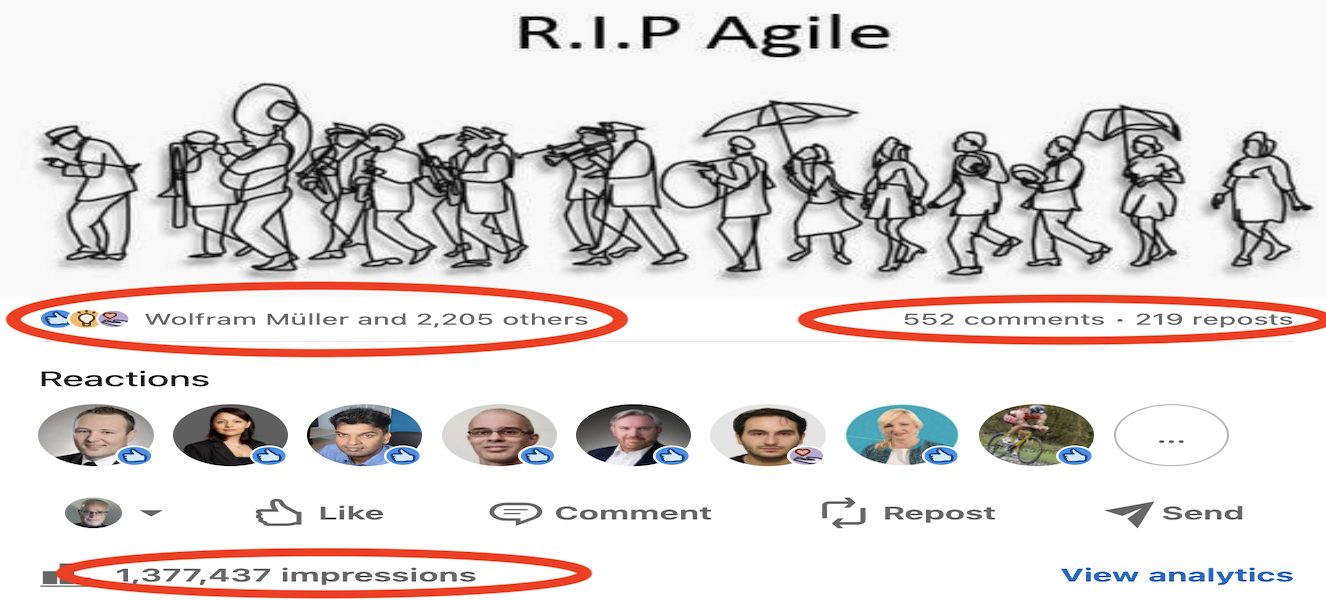2023 Year End Message
“Agile” as we know it is in decline – and that’s good
We have been saying for a long time that the Agile movement went off the rails and was not a good place to look for lessons about true organizational agility. Indeed, that reality was the motivation behind the Agile 2 project – to reimagine agility in a more thoughtful way.
Agility is still needed in the age of AI, but "Agile" will not produce it. A learning and development approach will.
In recent years, C level executives began talking about “Agile”, expecting that it would help them to move faster and be more flexible, but they have since become disillusioned with what “Agile” offers and are turning their focus elsewhere – to pressing concerns like AI, and returning to a focus on leadership.
People sense the shift. That’s why a recent post in LinkedIn about the decline of the Agile movement went viral, achieving 1.3 million views and more than 200 reposts in only the first four days (see image). (This Newsletter article of ours examines the responses to the post.)
The dilemma is that we still need agility – more than ever! But the Agile community is not the place to look for how to achieve true agility.
The good news is that you can improve agility. We know: we are helping companies to do it!
Client successes
We have been helping a $5B company to shift from using “Agile” roles, by turning most people in those roles into management track leaders who lead using behaviors that promote organizational agility. To do that, we are using our Constructive Agility System (see below), along with other kinds of support.
We have been helping a $5B company to shift from using “Agile” roles, by turning most people in those roles into management track leaders.
We have been helping a major research institute in South Africa to get up and running, having previously helped them to develop their vision and core strategies, which included a strong focus on shortening the gaps between exploratory research and therapy development, and being maximally interdisciplinary and collaborative. The university has now established core leadership teams, has procured a set of eleven buildings for the institute and other related research teams, and is well on the way in implementing the strategies.
And more: We have advised other organizations, including the Infectious Diseases Society of America. And quite a few companies and government organizations (in the US and the UK) have taken our training.
Productization of our most important toolkit
We productized our toolkit for Constructive AgilityⓇ – our systematic approach for increasing true agility. The toolkit is called the Constructive Agility System, and it includes a real time metrics dashboard that proves that actual agility is improving!
We have also developed a set of leadership seminars on special topics, including Beyond Budgeting, Leader Character (based on the Ivey Business School “Leader Character” model), Generative Leadership, Working Effectively Across Country Cultures, Building Relationships Needed for Success In a Complex Data-Driven World, and others.
What’s next
Many of the AI-based tools that are emerging for product development are “copilots”, and this changes how engineers work. We are updating our training and workshops to reflect that new way of working.
We are also adding AI-based tools to the Constructive Agility System. These are designed to help people in leadership roles, including the executive level, manager level, product level, and team level. We conceptualized these tools a year ago, but have been waiting for OpenAI to add certain features to their product.
We hope that 2023 has been successful for you, and we look forward to helping you to be even more successful in 2024!



